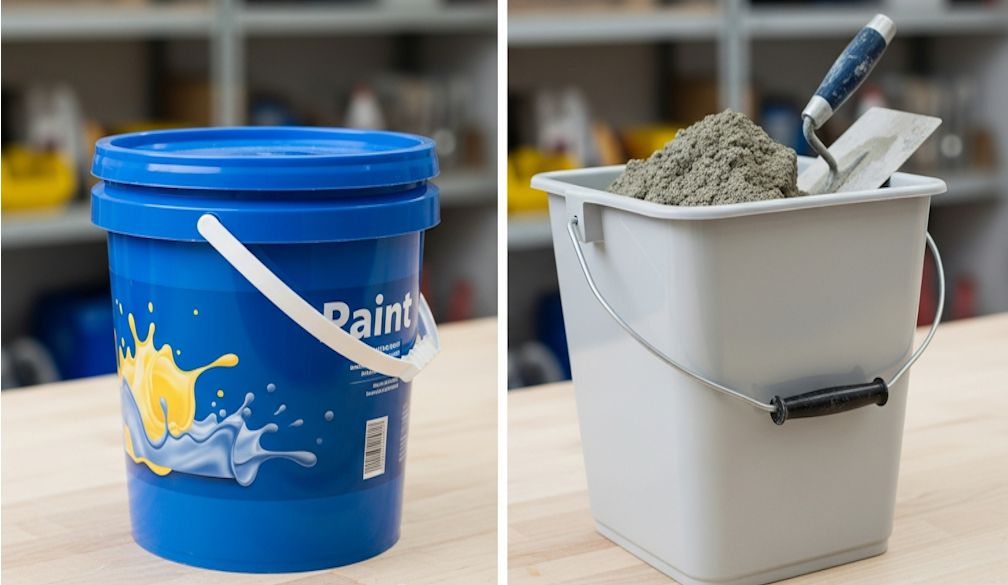Plastic Pails vs. Plastic Buckets: Which is Right for Your Storage Needs?

Choosing between plastic pails and plastic buckets might seem like a small decision, but it can make a big difference in how effectively you store and transport materials. Both options offer durability, versatility and ease of use, yet each has its own advantages depending on the job at hand. This article will break down the differences, uses and benefits of each to help you choose the right one for your storage needs.
Understanding the Difference Between Plastic Pails and Plastic Buckets
Although plastic pails and plastic buckets are often used interchangeably, there are subtle distinctions between them. A pail typically features a tapered shape with a handle and lid, designed for easy pouring and transport. Buckets, on the other hand, often have straight sides and are intended for holding or mixing materials rather than dispensing them. Both are made from strong, impact-resistant plastics like high-density polyethylene (HDPE), which makes them lightweight yet durable enough for industrial and domestic use. The key is understanding which shape and design best suits your specific purpose.
When to Use Plastic Pails
Plastic pails are ideal for applications that require secure, sealed storage and easy handling. They often come with snap-on or tamper-evident lids, making them popular in industries like food manufacturing, cleaning, agriculture and chemicals. Their smooth interior walls prevent residue build-up, which is especially useful for products like paints, sauces or detergents. The tapered design also allows for simple stacking and space-saving storage when empty. For businesses that need reliable packaging solutions, pails provide an excellent balance between portability and protection. They’re also commonly approved for food-grade use, which means they’re safe for storing ingredients or consumables without contamination risk.
When to Use Plastic Buckets
Plastic buckets tend to be the better option for heavy-duty use. Their straight-sided structure and strong base make them ideal for mixing materials like plaster, concrete or cleaning solutions. They’re also easier to use with larger tools or for scooping contents. Many households rely on buckets for cleaning, gardening or water storage due to their convenience and affordability. For industries dealing with large volumes of non-perishable goods, buckets offer a practical way to store or transport materials without requiring sealed lids. Their open-top design allows quick access to contents, making them more suitable for repetitive use throughout the day.
Material and Durability Considerations
Both plastic pails and plastic buckets are typically made from HDPE or polypropylene – materials known for their strength and chemical resistance. HDPE versions are especially tough, withstanding temperature fluctuations and heavy loads without cracking. For outdoor use or exposure to chemicals, it’s important to choose containers rated for UV and chemical resistance. Thicker-walled designs can handle rough handling or stacking in warehouses, while lighter-weight options are better for frequent manual use. When maintained properly, these containers can last for years, providing excellent value for both commercial and home applications.
Key Factors to Consider Before Buying
Before purchasing, think about the container’s intended use. If portability and airtight sealing matter most, plastic pails are generally the better choice. If you’re after open, easily accessible containers for mixing or transport, plastic buckets might be more suitable. Capacity, lid type and handle strength will all influence how functional the container will be. Stackability is another consideration. Tapered pails often nest neatly when empty, while buckets may require more space but provide better stability when full. Checking the manufacturer’s specifications for load capacity and material certification will ensure you get containers that meet your exact requirements.
Conclusion
Both plastic pails and plastic buckets offer a durable, versatile storage solution suited to a wide range of needs. Pails are ideal for sealed, portable storage where safety and cleanliness are priorities, while buckets excel in heavy-duty or open-use environments. Choosing between them comes down to the type of material, how often the container will be used and whether airtight protection is needed. Regardless of the application, these plastic containers continue to provide dependable, cost-effective storage.

